英语教学理论与实践
小学英语教学理论实践(3篇)

第1篇摘要:本文旨在探讨小学英语教学理论在实践中的应用,分析当前小学英语教学中存在的问题,并提出相应的改进策略。
通过结合教育心理学、语言学习理论等,探讨如何提高小学英语教学效果,促进学生英语能力的全面发展。
一、引言随着我国对外开放的不断深入,英语作为国际通用语言的重要性日益凸显。
小学英语教学作为英语学习的起点,对于培养学生的英语素养和跨文化交际能力具有重要意义。
本文从理论层面出发,结合实践,探讨小学英语教学的理论与实践。
二、小学英语教学理论1. 教育心理学理论教育心理学理论认为,学生的认知发展、情感态度、动机等因素对学习效果有重要影响。
在小学英语教学中,教师应关注学生的心理需求,激发学生的学习兴趣,培养学生的学习动机。
2. 语言学习理论语言学习理论主要包括行为主义理论、认知主义理论和社会文化理论。
行为主义理论强调通过模仿、重复等方式学习语言;认知主义理论强调通过思维、记忆、理解等方式学习语言;社会文化理论强调通过社会互动、文化传承等方式学习语言。
在小学英语教学中,教师应结合不同理论,采取合适的教学方法。
3. 交际语言教学理论交际语言教学理论认为,语言学习的目的是为了交流,教学应以学生为中心,注重培养学生的交际能力。
在小学英语教学中,教师应创设真实的语言环境,让学生在实际交流中运用英语。
三、小学英语教学实践1. 创设良好的学习氛围(1)营造轻松、愉快的课堂氛围,让学生在轻松的环境中学习英语。
(2)鼓励学生积极参与课堂活动,培养学生的自信心。
2. 注重学生个体差异(1)了解学生的英语水平,针对不同层次的学生制定合适的教学计划。
(2)关注学生的学习需求,关注学生的情感态度,实施个性化教学。
3. 采用多样化的教学方法(1)运用多媒体技术,丰富教学内容,提高学生的学习兴趣。
(2)采用游戏、故事、歌曲等多种教学手段,激发学生的学习兴趣。
(3)组织小组合作、角色扮演等活动,提高学生的交际能力。
4. 加强听说读写训练(1)注重听力的培养,提高学生的听力理解能力。
基于主题意义探究的英语教学理论与实践
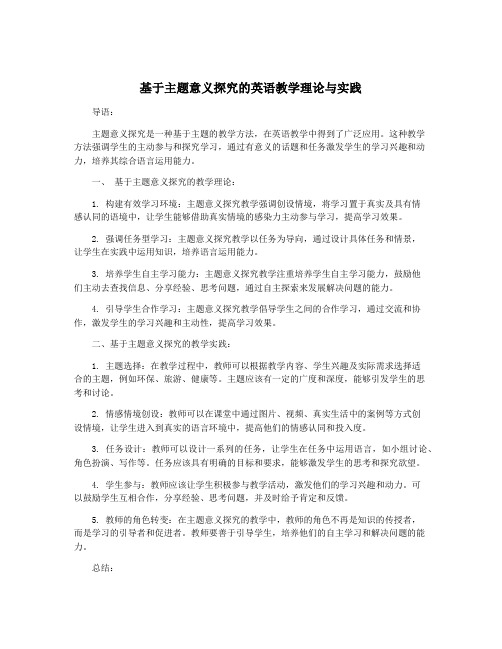
基于主题意义探究的英语教学理论与实践导语:主题意义探究是一种基于主题的教学方法,在英语教学中得到了广泛应用。
这种教学方法强调学生的主动参与和探究学习,通过有意义的话题和任务激发学生的学习兴趣和动力,培养其综合语言运用能力。
一、基于主题意义探究的教学理论:1. 构建有效学习环境:主题意义探究教学强调创设情境,将学习置于真实及具有情感认同的语境中,让学生能够借助真实情境的感染力主动参与学习,提高学习效果。
2. 强调任务型学习:主题意义探究教学以任务为导向,通过设计具体任务和情景,让学生在实践中运用知识,培养语言运用能力。
3. 培养学生自主学习能力:主题意义探究教学注重培养学生自主学习能力,鼓励他们主动去查找信息、分享经验、思考问题,通过自主探索来发展解决问题的能力。
4. 引导学生合作学习:主题意义探究教学倡导学生之间的合作学习,通过交流和协作,激发学生的学习兴趣和主动性,提高学习效果。
二、基于主题意义探究的教学实践:1. 主题选择:在教学过程中,教师可以根据教学内容、学生兴趣及实际需求选择适合的主题,例如环保、旅游、健康等。
主题应该有一定的广度和深度,能够引发学生的思考和讨论。
2. 情感情境创设:教师可以在课堂中通过图片、视频、真实生活中的案例等方式创设情境,让学生进入到真实的语言环境中,提高他们的情感认同和投入度。
3. 任务设计:教师可以设计一系列的任务,让学生在任务中运用语言,如小组讨论、角色扮演、写作等。
任务应该具有明确的目标和要求,能够激发学生的思考和探究欲望。
4. 学生参与:教师应该让学生积极参与教学活动,激发他们的学习兴趣和动力。
可以鼓励学生互相合作,分享经验、思考问题,并及时给予肯定和反馈。
5. 教师的角色转变:在主题意义探究的教学中,教师的角色不再是知识的传授者,而是学习的引导者和促进者。
教师要善于引导学生,培养他们的自主学习和解决问题的能力。
总结:基于主题意义探究的教学方法能够有效激发学生的学习兴趣和动机,培养他们的综合语言运用能力。
大学英语备课中的课堂实践与理论结合
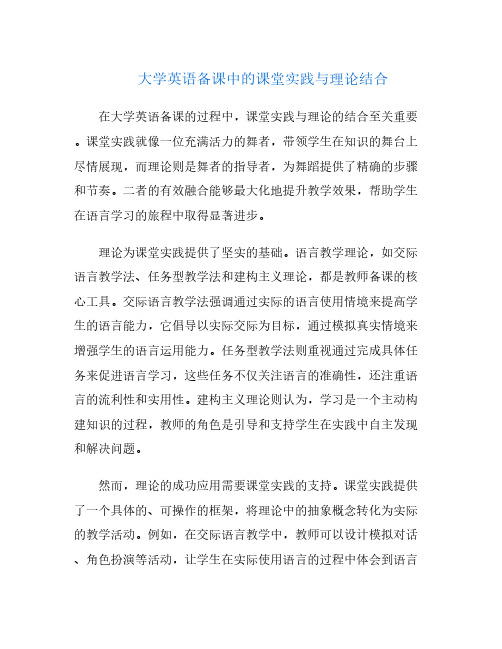
大学英语备课中的课堂实践与理论结合在大学英语备课的过程中,课堂实践与理论的结合至关重要。
课堂实践就像一位充满活力的舞者,带领学生在知识的舞台上尽情展现,而理论则是舞者的指导者,为舞蹈提供了精确的步骤和节奏。
二者的有效融合能够最大化地提升教学效果,帮助学生在语言学习的旅程中取得显著进步。
理论为课堂实践提供了坚实的基础。
语言教学理论,如交际语言教学法、任务型教学法和建构主义理论,都是教师备课的核心工具。
交际语言教学法强调通过实际的语言使用情境来提高学生的语言能力,它倡导以实际交际为目标,通过模拟真实情境来增强学生的语言运用能力。
任务型教学法则重视通过完成具体任务来促进语言学习,这些任务不仅关注语言的准确性,还注重语言的流利性和实用性。
建构主义理论则认为,学习是一个主动构建知识的过程,教师的角色是引导和支持学生在实践中自主发现和解决问题。
然而,理论的成功应用需要课堂实践的支持。
课堂实践提供了一个具体的、可操作的框架,将理论中的抽象概念转化为实际的教学活动。
例如,在交际语言教学中,教师可以设计模拟对话、角色扮演等活动,让学生在实际使用语言的过程中体会到语言的魅力和功能。
通过这些活动,学生不仅能够提高语言能力,还能够增强自信心和沟通能力。
任务型教学法同样需要通过具体的任务来落实,例如设计项目作业、组织小组讨论等,以促进学生在实际操作中运用语言,从而加深对语言的理解和掌握。
结合理论与实践的过程,也涉及到对教学效果的不断评估与调整。
教师需要在实际教学中观察学生的表现,了解他们在语言运用中的困难和需求。
根据这些反馈,教师可以对教学策略进行调整,以确保理论的应用能够真正解决学生面临的实际问题。
例如,如果发现学生在角色扮演活动中表现不佳,教师可以分析问题的根源,可能是任务设计不合理,或者学生对任务要求理解不够清晰。
通过调整任务内容或提供更明确的指导,教师可以帮助学生更好地完成任务,从而提高他们的语言能力。
此外,课堂实践和理论的结合也有助于激发学生的学习兴趣和动力。
小学英语教学法:从理论到实践

小学英语教学法:从理论到实践近几年来,英语教学理论及实践改革受到了越来越多的关注,对小学英语教学法也催生了新的观念与理论,更加注重学习可能性、启发性和动机性,深入揭示英语学习过程及其规律。
本文从理论层面介绍小学英语教学法,并进一步结合教学实践,讨论它的实施原则以及存在的问题。
一、小学英语教学的理论基础小学英语教学的理论基础是建构主义教学理论、语言双层次理论以及可塑性理论,它们相互联系、相互促进。
1.建构主义教学理论建构主义教学理论认为学习是一个构建新知识和技能的过程,教师应该为学生提供良好的学习环境,让学生能够主动探索新领域,有趣而又有意义地学习,并且给他们提供尝试失败、反思与自我调整的机会。
因此,建构主义教育的重点落在课程的互动性、主动性和有趣性,强调师生共同构建新的知识,这是小学英语教学的基石。
2.语言双层次理论语言双层次理论认为,学习一门外语要有效掌握,一定要正确认识结构,并能够运用它们来表吟表达意思,即学习者要掌握语言的双层次:形式与功能的双层次,因此,教师要在小学英语教学中注重对语言结构及功能的教学,重视口语表达,让学生对考察任务有足够的准备。
3.可塑性理论可塑性理论强调,脑的发育及功能可“可塑”,也就是说,人的大脑更加容易受到外部、环境及学习等因素的影响。
在小学英语教学中,可塑性理论提供了一种重视学生焦点及发展的新思路,让教师了解学生的发展特征,为学生提供有尊重、个性化及灵活性的学习环境。
二、小学英语教学实践1.原则小学英语教学实践主要遵循以下原则:A.把英语学习置于语言使用的实际环境中,并给学生真实的机会去表达和沟通,增强学生的主动性;B.加强交流,以真实的交流及活动为导向,使学习更加自然,从而激发学生的学习兴趣;C.注重学生的个性发展,重视他们的结构能力及技能;D.发挥学生的活动思维,通过语言活动培养他们的想象力,鼓励学生不断求知,挑战新知识;E.结合情境来教学,给学生更真实的英语环境,促使他们用英语自如的思考和表达,增强使用英语的自信。
《大学英语教育》理论与实践的思政案例

《大学英语教育》理论与实践的思政案例引言大学英语教育是我国高等教育的重要组成部分,不仅关系到学生的学术发展和国际视野的拓展,还对其思想政治素质的提升有着深远影响。
本文通过分析大学英语教育的理论与实践,探讨如何在英语教学中融入思想政治教育,以实现高等教育的人才培养目标。
理论依据1. 教育方针:根据我国的《教育法》和《高等教育法》,高等教育必须坚持社会主义方向,培养德、智、体全面发展的社会主义建设者和接班人。
教育方针:根据我国的《教育法》和《高等教育法》,高等教育必须坚持社会主义方向,培养德、智、体全面发展的社会主义建设者和接班人。
2. 课程性质:大学英语作为一门通识教育课程,具有工具性和人文性双重性质。
工具性强调英语作为交流工具的重要性,人文性则强调通过英语研究,了解外国文化,提升跨文化交际能力。
课程性质:大学英语作为一门通识教育课程,具有工具性和人文性双重性质。
工具性强调英语作为交流工具的重要性,人文性则强调通过英语学习,了解外国文化,提升跨文化交际能力。
3. 思想政治教育原则:在英语教学中融入思想政治教育,应遵循潜移默化、因材施教、寓教于乐的原则,使学生在研究英语的过程中自然地接受思想政治教育。
思想政治教育原则:在英语教学中融入思想政治教育,应遵循潜移默化、因材施教、寓教于乐的原则,使学生在学习英语的过程中自然地接受思想政治教育。
实践案例1. 课程内容融入思想政治元素在英语教材和教学内容的选取上,注重选择体现外国优秀文化、符合社会主义核心价值观的素材。
例如,在教授英语文学作品时,引导学生正确理解作品中的道德观、价值观,并与我国的社会主义核心价值观进行对比和思考。
2. 教学方法创新运用现代教育技术,如在线教学平台、多媒体教学等,开展互动式、讨论式教学,激发学生的思考和兴趣。
通过小组讨论、角色扮演等形式,让学生在实践中提高英语应用能力,同时培养团队协作精神和批判性思维。
3. 教师队伍建设加强英语教师的思政教育培训,确保教师在教学中能够自然融入思想政治教育。
中小学英语阅读教学理论与实践
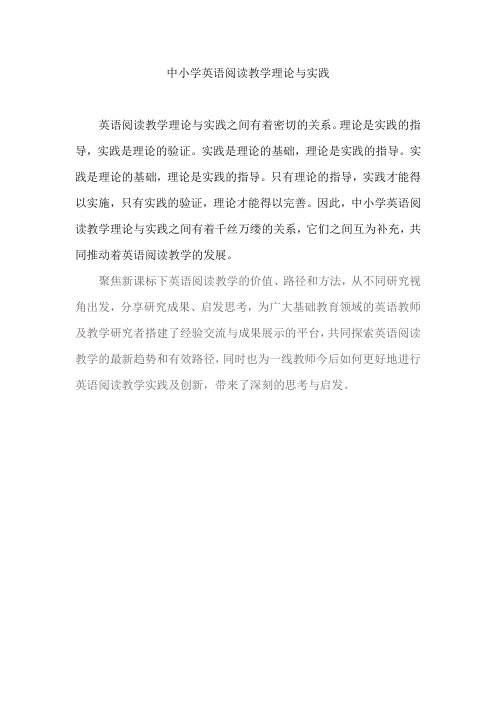
中小学英语阅读教学理论与实践
英语阅读教学理论与实践之间有着密切的关系。
理论是实践的指导,实践是理论的验证。
实践是理论的基础,理论是实践的指导。
实践是理论的基础,理论是实践的指导。
只有理论的指导,实践才能得以实施,只有实践的验证,理论才能得以完善。
因此,中小学英语阅读教学理论与实践之间有着千丝万缕的关系,它们之间互为补充,共同推动着英语阅读教学的发展。
聚焦新课标下英语阅读教学的价值、路径和方法,从不同研究视角出发,分享研究成果、启发思考,为广大基础教育领域的英语教师及教学研究者搭建了经验交流与成果展示的平台,共同探索英语阅读教学的最新趋势和有效路径,同时也为一线教师今后如何更好地进行英语阅读教学实践及创新,带来了深刻的思考与启发。
英语写作教学理论与实践

英语写作教学理论与实践一、本文概述《英语写作教学理论与实践》是一篇旨在探讨英语写作教学领域理论与实践相结合的重要文章。
本文将从英语写作教学的现状出发,分析当前英语写作教学中存在的问题与挑战,进而提出有效的解决策略。
文章将重点介绍英语写作教学的基本理论,包括英语写作教学的目标、原则和方法,同时结合实际教学案例,阐述如何将这些理论应用于实际教学中。
本文还将探讨英语写作教学中学生自主学习能力的培养,以及教师在英语写作教学中的角色定位。
通过本文的阐述,旨在为广大英语教师提供一套系统、实用的英语写作教学指导方案,以促进英语写作教学的质量提升和学生英语写作能力的全面发展。
二、英语写作教学理论在英语写作教学中,理论是指导实践的重要基础。
英语写作教学理论涉及多个方面,包括写作过程理论、写作认知理论、写作评估理论等。
这些理论为英语写作教学提供了系统的框架和科学的指导,有助于教师更好地理解和指导学生的写作过程。
写作过程理论强调写作是一个循环往复的过程,包括构思、起草、修改和校对等阶段。
这一理论鼓励教师在教学过程中注重学生的写作过程而非结果,帮助学生掌握有效的写作策略,提高写作技能。
写作认知理论关注写作过程中学生的认知活动。
它认为写作是一种复杂的认知过程,涉及语言、思维、记忆等多个方面。
教师在教学过程中应注重培养学生的认知能力和写作策略,帮助学生更好地理解和运用语言。
写作评估理论为评估学生的写作水平提供了科学的依据。
它强调评估的多元性和动态性,注重学生的个体差异和进步。
通过有效的评估,教师可以了解学生的学习情况,及时调整教学策略,促进学生的英语写作水平不断提高。
英语写作教学理论在英语写作教学中发挥着至关重要的作用。
它有助于教师系统地指导学生的写作过程,提高学生的写作技能,同时也有助于教师科学评估学生的写作水平,调整教学策略,促进学生的全面发展。
在未来的英语写作教学中,我们应继续深化理论研究,探索更加有效的教学方法和手段,为学生的英语写作能力发展提供有力支持。
英语教育理论及教学实践(3篇)

第1篇Introduction:English education has been a significant part of global education for decades. The development of English education theory and teachingpractice has been constantly evolving to meet the needs of students in different contexts. This paper aims to explore the key theories and practices in English education, highlighting their importance in achieving effective language learning outcomes.I. Theories of English Education1. Behaviorist Theory:Behaviorist theory, represented by B.F. Skinner, suggests that language learning is a process of habit formation. Students acquire language by responding to stimuli and being reinforced for correct responses. This theory emphasizes the importance of repetition, practice, and positive reinforcement in language learning.2. Cognitive Theory:Cognitive theory, advocated by Noam Chomsky, focuses on the internal mental processes of language acquisition. This theory argues that learners have an innate capacity to acquire language and that they construct their own understanding of language through internal cognitive processes.3. Sociocultural Theory:Sociocultural theory, proposed by Lev Vygotsky, emphasizes the role of social interaction in language learning. This theory suggests that learners develop language skills through interaction with more knowledgeable others, such as teachers and peers. Collaborative learning, scaffolding, and peer tutoring are essential components of this theory.4. Humanistic Theory:Humanistic theory, represented by Carl Rogers, emphasizes the importance of individual learning styles and self-concept. This theory emphasizesthe role of the learner's emotions, motivation, and personal values in language learning. Teachers are encouraged to create a supportive and empathetic learning environment that fosters intrinsic motivation.II. Teaching Practices in English Education1. Task-Based Language Teaching (TBLT):TBLT is an approach that focuses on authentic communication tasks. Teachers design tasks that require students to use the target language in real-life contexts. This approach encourages students to develop their language skills through interaction and collaboration.2. Communicative Language Teaching (CLT):CLT emphasizes the importance of communication in language learning. Teachers create activities that promote interaction and allow students to practice language in a meaningful context. This approach helps students develop fluency and accuracy in the target language.3. Content-Based Instruction (CBI):CBI integrates content from other disciplines into language learning. This approach allows students to learn language while acquiring knowledge in a specific subject area. CBI helps students develop language skills that are relevant to their academic and professional lives.4. Technology-Enhanced Language Learning (TELL):TELL utilizes technology to support language learning. Teachers incorporate digital tools, such as interactive whiteboards, educational software, and online resources, into their lessons. This approach enhances student engagement and provides opportunities for personalized learning.III. Importance of Theories and Practices in English Education1. Achieving Effective Language Learning Outcomes:By understanding and implementing various theories and practices, teachers can create a more effective learning environment that caters to the diverse needs of students. This leads to improved language proficiency and overall learning outcomes.2. Addressing Individual Learning Styles:Different theories and practices cater to different learning styles. By incorporating a variety of approaches, teachers can ensure that students with diverse learning preferences can succeed in their language learning journey.3. Fostering Motivation and Engagement:Effective teaching practices, such as TBLT and CLT, encourage students to actively engage in language learning. This promotes intrinsic motivation and helps students develop a genuine interest in the target language.4. Preparing Students for Real-Life Situations:By incorporating authentic tasks and content-based instruction, teachers prepare students for real-life communication and academic challenges. This helps students develop language skills that are applicable in various contexts.Conclusion:English education theory and teaching practice are essential components of effective language learning. By understanding and implementing various theories and practices, teachers can create a more engaging and supportive learning environment for their students. This leads to improved language proficiency, motivation, and overall success in English education.第2篇English language education has become an integral part of the educational landscape worldwide. The field is characterized by a rich tapestry of theories and pedagogical practices that aim to facilitateeffective language learning. This paper explores some key theoretical frameworks and their application in teaching English, providing insights into how these theories can be practically implemented in the classroom.Theoretical Frameworks in English Language Education1. Theoretical Approaches to Language Learning- Behaviorist Theory: This theory, rooted in the work of B.F. Skinner, posits that language learning is a process of habit formation. Through repetition and reinforcement, learners acquire language skills. Teachers employing this approach focus on explicit instruction, drilling, and repetition.- Cognitive Theory: Cognitive psychologists like Lev Vygotsky emphasize the role of mental processes in language learning. This theory suggests that learners construct knowledge through social interactionand collaboration. Teachers using this approach create opportunities for learners to engage in meaningful conversations and activities that promote critical thinking.- Social Constructivist Theory: Proposed by Lev Vygotsky and further developed by others, this theory emphasizes the importance of social interaction and cultural context in language learning. Learnersconstruct meaning through their interactions with others, and teachers facilitate these interactions by creating a supportive and collaborative learning environment.- Humanistic Theory: This approach, influenced by the work of Carl Rogers and Abraham Maslow, focuses on the emotional and psychological needs of the learner. Teachers employing humanistic techniques aim to create a positive and empathetic learning environment that fosters self-esteem and intrinsic motivation.2. Methodologies in English Language Teaching- Direct Method: Also known as the audio-lingual method, this approach emphasizes oral communication and uses the target language asmuch as possible. Teachers focus on vocabulary and grammar in a structured and systematic manner.- Audio-Lingual Method: Similar to the direct method, this approach uses audio-visual aids and repetition to teach language skills. It focuses on the mimicry and repetition of phrases and sentences.- Communicative Language Teaching (CLT): CLT emphasizes communication as the primary goal of language learning. Teachers design activitiesthat allow learners to practice language in real-life contexts, focusing on fluency rather than accuracy.- Task-Based Language Teaching (TBLT): TBLT involves learners in completing tasks that require them to use the language in a meaningful way. Tasks are designed to be authentic and relevant to the learners' lives.Pedagogical Practices in English Language Education1. Task-Based LearningTask-based learning involves designing activities that require learners to complete a specific task using the target language. These tasks should be meaningful, relevant, and engaging. For example, a teacher might assign a group project where students have to create a presentation about a cultural event in English.2. Flipped ClassroomThe flipped classroom model involves students watching instructional videos or completing readings at home, and then using class time for interactive activities and discussions. This approach allows teachers to focus on providing individualized attention and guidance.3. Technology IntegrationTechnology can be a powerful tool in English language education. Teachers can use various software and apps to create interactive lessons, provide feedback, and track student progress. For instance, educationalplatforms like Duolingo and Rosetta Stone offer interactive language learning experiences.4. Collaborative LearningCollaborative learning encourages students to work together in pairs or groups to achieve a common goal. This approach promotes communication skills, teamwork, and critical thinking. Teachers can facilitate collaborative learning by assigning group projects or discussion activities.5. Authentic MaterialsUsing authentic materials, such as newspapers, magazines, and videos, can make learning more engaging and relevant. Authentic materials allow learners to encounter the target language in its natural context and develop their language skills in a practical manner.ConclusionTheoretical frameworks and pedagogical practices in English language education are essential tools for teachers seeking to create effective and engaging learning experiences. By understanding and applying these theories and practices, teachers can help learners develop their language skills in a meaningful and enjoyable way. As the field of English language education continues to evolve, it is crucial for educators to remain adaptable and open to new ideas and approaches.第3篇Introduction:English education plays a crucial role in the globalized world, as it serves as a bridge for communication, culture, and knowledge exchange. This paper aims to explore the theoretical framework and teaching practices in English education, highlighting the importance of integrating theory with practical strategies to enhance learning outcomes. By analyzing various theories and practices, this paper will provide insights into effective English language teaching methods and their application in real-life classroom settings.I. Theoretical Framework1. Behaviorist TheoryBehaviorist theory, developed by B.F. Skinner, emphasizes the role of environmental factors and reinforcement in learning. In English education, this theory suggests that learners acquire language through repetition, imitation, and reinforcement. Teachers can implement this theory by using techniques such as rote learning, repetition drills, and positive reinforcement to encourage language practice.2. Cognitive TheoryCognitive theory, proposed by Jean Piaget, focuses on the internal mental processes involved in learning. According to this theory, learners construct knowledge through their interactions with the environment. In English education, teachers can apply cognitive theory by promoting critical thinking, problem-solving, and active learning. Techniques such as project-based learning, inquiry-based learning, and cooperative learning can be utilized to foster students' cognitive development.3. Communicative Language Teaching (CLT)Communicative Language Teaching is a method that emphasizes communication as the primary goal of language learning. This theory suggests that learners should be provided with opportunities to engagein real-life communication activities. Teachers can incorporate CLT into their English classes by using activities such as role-playing, debates, and discussions to enhance students' speaking and listening skills.4. Humanistic TheoryHumanistic theory, as proposed by Carl Rogers, emphasizes the importance of the learner's emotional and psychological well-being in the learning process. In English education, this theory suggests that teachers should create a supportive and positive learning environment that fosters students' self-esteem and autonomy. Techniques such as student-centeredlearning, self-assessment, and reflection can be employed to promote students' personal development.II. Teaching Practices1. Needs AnalysisBefore designing a lesson plan, it is essential for teachers to conduct a needs analysis to identify the specific language requirements and learning objectives of their students. This involves assessing students' proficiency levels, interests, and learning styles. Based on this information, teachers can tailor their teaching methods and materials to meet the individual needs of their students.2. Language Skills DevelopmentIn English education, it is crucial to focus on the development of all four language skills: listening, speaking, reading, and writing. Teachers can implement various activities and techniques to enhance these skills. For example, listening exercises can include listening to audio clips or watching videos, speaking activities can involve group discussions or presentations, reading tasks can include reading articles or analyzing texts, and writing assignments can range from short essays to creative writing.3. Task-Based Language Teaching (TBLT)Task-based language teaching involves designing lessons around authentic tasks that require students to use the language in real-life contexts. This approach encourages students to engage in meaningful communication and develop language skills naturally. Teachers can create tasks that simulate real-life situations, such as role-plays, simulations, or problem-solving activities.4. Technology IntegrationIncorporating technology into English education can enhance students' learning experiences and engagement. Teachers can utilize variousdigital tools and resources, such as online platforms, educational apps, and multimedia materials, to facilitate language learning. For instance,students can use language learning software to practice grammar or vocabulary, or teachers can create interactive lessons using multimedia presentations.5. Assessment and FeedbackRegular assessment and feedback are essential for monitoring students' progress and identifying areas for improvement. Teachers can employ various assessment methods, such as formative and summative assessments, quizzes, and projects. Constructive feedback should be provided to students to guide their learning and help them develop their language skills.Conclusion:In conclusion, the theoretical framework and teaching practices in English education encompass a range of theories and techniques that can be effectively applied in the classroom. By integrating these theories with practical strategies, teachers can create a dynamic and engaging learning environment that promotes language acquisition and personal development. Continuous reflection and adaptation of teaching methods are essential to meet the evolving needs of students and ensureeffective English education.。
大学英语教学三年备课的理论与实践
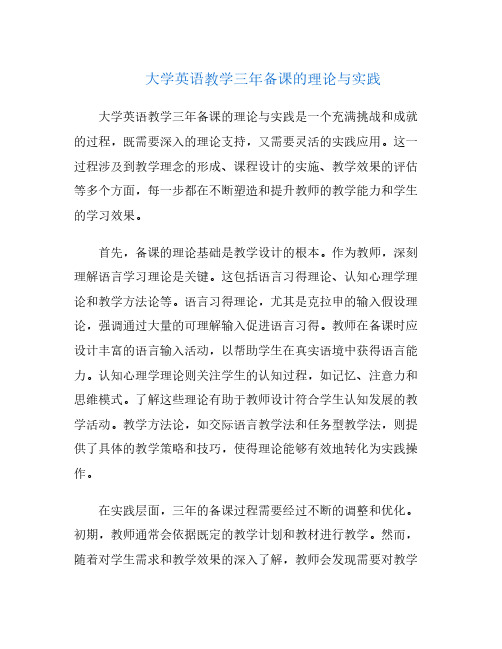
大学英语教学三年备课的理论与实践大学英语教学三年备课的理论与实践是一个充满挑战和成就的过程,既需要深入的理论支持,又需要灵活的实践应用。
这一过程涉及到教学理念的形成、课程设计的实施、教学效果的评估等多个方面,每一步都在不断塑造和提升教师的教学能力和学生的学习效果。
首先,备课的理论基础是教学设计的根本。
作为教师,深刻理解语言学习理论是关键。
这包括语言习得理论、认知心理学理论和教学方法论等。
语言习得理论,尤其是克拉申的输入假设理论,强调通过大量的可理解输入促进语言习得。
教师在备课时应设计丰富的语言输入活动,以帮助学生在真实语境中获得语言能力。
认知心理学理论则关注学生的认知过程,如记忆、注意力和思维模式。
了解这些理论有助于教师设计符合学生认知发展的教学活动。
教学方法论,如交际语言教学法和任务型教学法,则提供了具体的教学策略和技巧,使得理论能够有效地转化为实践操作。
在实践层面,三年的备课过程需要经过不断的调整和优化。
初期,教师通常会依据既定的教学计划和教材进行教学。
然而,随着对学生需求和教学效果的深入了解,教师会发现需要对教学内容和方法进行灵活调整。
例如,在第一年,教师可能会更多地依赖传统的讲授和练习活动,而在后续的备课中,逐渐加入更多互动性强的活动,如小组讨论和角色扮演,以提高学生的语言应用能力。
此外,通过课堂观察和学生反馈,教师能够实时了解教学效果,并根据学生的实际情况调整教学策略。
评估和反馈是备课过程中不可忽视的环节。
教学评估不仅仅是对学生学习成果的评价,更是对教学方法和策略的检验。
教师需要定期对教学进行自我评估,通过学生的学习成果、课堂参与情况以及课堂外的语言运用能力等多个方面进行综合评价。
同时,教师还应积极收集学生的反馈意见,了解他们在学习过程中的困难和需求。
这些反馈可以帮助教师及时调整教学计划,改进教学方法,从而更好地支持学生的语言学习。
另外,与同行的交流和学习也是备课过程中重要的一环。
通过参加教学研讨会、观摩他人的教学以及与同行分享经验,教师能够获得新的教学理念和方法。
英语教学理论与实践第一讲 英语教学的系统工程

英语教学理论与实践第一讲英语教学的系统工程教育学与语言学:1、教育学理论;2、理论语言学语音学和音系学词汇学句法学语义学;3、不同的语言观把语言看作是一门知识把语言看成一种技能把语言看成是一种社会规约社会语言学:1、,sociolinguistics;2、方言;3、语体;4、语域;5、语体变换;6、语言规划;7、语言的变化心理语言学:1、Psycholinguistics;2、人们学习和使用语言的心理过程;3、语言习得;4、言语的产生;5、言语的理解应用语言学: 1、Applied linguistics;2、广义和狭义;3、比较分析和错误分析;4、教学法研究;5、学习者的个体差异(智力、语言学能;学习方式;学习策略,学习动机;学习兴趣、家庭环境等)5、语言测试;6、教学文件(教学大纲;课程标准;课程性质、课程目标、内容标准,以及对此标题的实施建议,另外还附有语音项目表,语法项目表。
功能意念表、话题项目表、技能教学参考表、课堂教学用语和词汇表;教师是实施教学的主体,教师要在充分理解课程标准,把握课程标准所依据语言学基础理论和应用语言学理论,采取适当的教学方法,完成课程标准所规定的教学目标。
在实施教学的过程中,还需要有相应的后勤保障,确保教学所需的教材与教具、教学设备准备到位。
)教师的素质:1、心理素质(情感、意志的性格的总体反映);2、语言素质(知识与技能、确保为学生提供高质量的语言输入、高质量的榜样作用)要给学生一杯水,教师要有一桶水,而且这桶水必须是新鲜流动的;3、文化素质(对英语国家的历史、地理、文学、风土人情、风俗习惯、人物典故等具有全面地了解对中国的文化具有全面地了解广博的知识面)4、理论素质(作用、lewin、重技能,轻理论的倾向)。
驾驭教材的素质:1、评价能力(教学的指导思想、所采用的教学方法、教材内容的选择和安排、教材的组成部分、教材中语言素材的真实性和地道性)2、使用能力(对教材内容适当的补充和删减、替换教学内容和活动、扩展况)。
英语教学理论与实践教学大纲
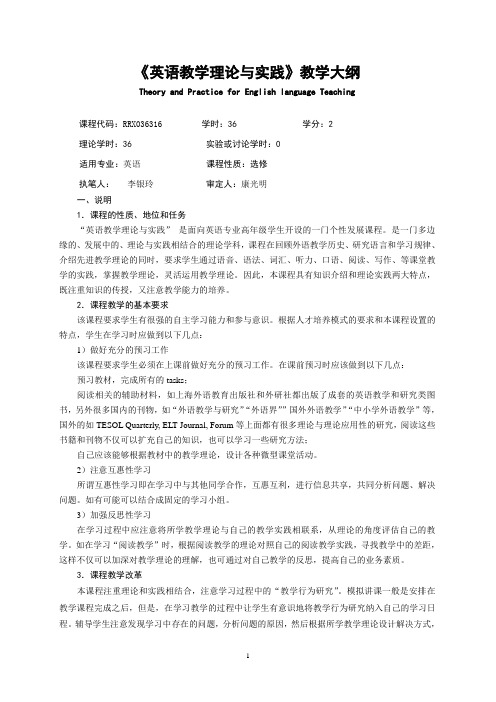
《英语教学理论与实践》教学大纲Theory and Practice for English language Teaching课程代码:RRX036316 学时:36 学分:2理论学时:36 实验或讨论学时:0适用专业:英语课程性质:选修执笔人:李银玲审定人:康光明一、说明1.课程的性质、地位和任务“英语教学理论与实践”是面向英语专业高年级学生开设的一门个性发展课程。
是一门多边缘的、发展中的、理论与实践相结合的理论学科,课程在回顾外语教学历史、研究语言和学习规律、介绍先进教学理论的同时,要求学生通过语音、语法、词汇、听力、口语、阅读、写作、等课堂教学的实践,掌握教学理论,灵活运用教学理论。
因此,本课程具有知识介绍和理论实践两大特点,既注重知识的传授,又注意教学能力的培养。
2.课程教学的基本要求该课程要求学生有很强的自主学习能力和参与意识。
根据人才培养模式的要求和本课程设置的特点,学生在学习时应做到以下几点:1)做好充分的预习工作该课程要求学生必须在上课前做好充分的预习工作。
在课前预习时应该做到以下几点:预习教材,完成所有的tasks;阅读相关的辅助材料,如上海外语教育出版社和外研社都出版了成套的英语教学和研究类图书,另外很多国内的刊物,如“外语教学与研究”“外语界””国外外语教学”“中小学外语教学”等,国外的如TESOL Quarterly, ELT Journal, Forum等上面都有很多理论与理论应用性的研究,阅读这些书籍和刊物不仅可以扩充自己的知识,也可以学习一些研究方法;自己应该能够根据教材中的教学理论,设计各种微型课堂活动。
2)注意互惠性学习所谓互惠性学习即在学习中与其他同学合作,互惠互利,进行信息共享,共同分析问题、解决问题。
如有可能可以结合成固定的学习小组。
3)加强反思性学习在学习过程中应注意将所学教学理论与自己的教学实践相联系,从理论的角度评估自己的教学。
如在学习“阅读教学”时,根据阅读教学的理论对照自己的阅读教学实践,寻找教学中的差距,这样不仅可以加深对教学理论的理解,也可通过对自己教学的反思,提高自己的业务素质。
英语教学理论与实践

Welcome to English Methodology!
By Ma Bingjun
Foreign Languages School of Fuyang Teachers College
1
பைடு நூலகம்
English Teaching Theory and Practice
No Reinforcement (behavior not likely to occur again )
16
Behaviorist Theory
• Skinner: Language is also a form of behaviour. • Language teaching in USA: The Audio-Lingual Method (the “listen-and-repeat” drilling activities). • In ALM, mistakes were immediately corrected.
(Harmer. 1983:30)
15
Behaviorist Theory
Reinforcement (behavior likely to occur again and become a habit)
Stimulus → Organism (beings)→ Response Behavior
The process-oriented language learning theory
• A process-oriented language learning theory is a theory built on describing learning processes, such as the following: 1. habit-formation 2. induction 3. Making inferences 4. hypothesis-testing (假设检验的方法) 5. generalization (概括)
新课程小学英语评课的理论与实践

新课程小学英语评课的理论与实践近几年来,随着新课程的推行,我国学校对对小学生英语认知能力和英语能力的提高有着越来越大的期望,同时也对英语教学活动进行了改革,提出了新的教学方法,而且也给小学教师提出了更高的要求。
如何实施新课程,能够有效提高学生英语能力,这也成为许多学校和教师关注的重要问题。
因此,对新课程小学英语评课的理论与实践进行研究,对于提高小学英语教学质量具有重要的意义。
一、新课程小学英语评课的理论依据新的小学英语课程的改革,在理论上可以从语言学习理论、教学理论、学习心理学等许多方面来支持。
(1)语言学习理论。
语言学习理论是指语言学习过程中学习者不断接受语言环境影响,经过复杂的过程,从而创造出适合自身活动的语言表达能力的一种学习理论。
具体来说,语言学习理论认为,学习者可以通过听、说、读、写等多种活动,不断接受语言环境的影响,从而达到学习语言的目的。
因此,小学英语课程评课时,可以考虑语言学习理论,从而提高教学效果。
(2)教学理论。
教学理论是指根据学习者的认知特点,结合课程教学要求,采取合理的教学策略,以最有效地完成教学目标为最终目标的一种理论。
这里所指的有效性指的是教师如何通过对教学内容的运用和对学生的指导,以达到有效的教学目标,实现英语教学效果的最佳状态。
因此,新课程小学英语评课时,也应该考虑教学理论,以提高教学效果。
(3)学习心理学。
学习心理学是研究学习过程中个体内在状态、行为,以及外部环境等方面的学习心理学理论。
学习心理学的研究可以帮助我们更好地了解学生的心理状态,帮助我们更好地针对性地调节学生的心理状态,使学生在英语学习中产生更大的动力,从而获得更好的学习效果。
因此,新课程小学英语评课时,也应考虑学习心理学,以提高教学效果。
以上就是新课程小学英语评课理论的基础,也是评课实践的前提。
二、新课程小学英语评课的实践(1)关注学生学习英语的具体情况。
新课程小学英语评课的实践应以积极的态度,关注学生的学习情况,了解其学习状况,把握其学习能力的强弱点,进而发掘其学习方法,并在后续评课中进行反馈和调整。
英语教育中的理论研究与教学实践

英语教育中的理论研究与教学实践随着全球化的发展,英语已经成为最具影响力的一个国际语种。
在中国,从小学到大学,英语教育始终是重中之重。
然而,英语教育也面临着很多困难和挑战。
这是因为英语教育不仅仅是学习一种语言,还包括语言的文化背景和思维方式。
在英语教育中,理论研究和教学实践都是非常重要的,两者相辅相成。
一、英语教育的理论研究英语教育的理论研究主要包括语言学、心理学和教育学三个方面的内容。
语言学是研究语言的学科,它对英语教育中的词汇、语法、语音和语用等方面的问题做出了很多研究。
教师们在教学中,需要充分了解这些研究成果,用科学的方法去分析解决学生的语言问题。
在语音教学中,知道汉语与英语音位对比差异,能帮助学生在发音方面得到提高。
在词汇教学中,要注意词汇的用法和搭配规律。
而在语法教学中,除了要教授语法知识,还要引导学生掌握句子的组织方式和语意结构,让学生提高语言组织的能力。
心理学是研究人的心理活动和行为的学科。
在英语教育中,心理学理论研究对教师起到了指导作用。
它可以帮助教师了解不同年龄段的学生的认知发展规律和语言习得方式,理解学生的情感需求,了解学生的交际意图和口语交际技能,帮助学生快速理解和运用英语语言。
比如,在教学中,要注意学生的自我语言使用问题,这可以帮助学生更好地习得英语。
教育学是研究教育现象和规律的学科,英语教育的教育学理论研究可以帮助教师把握教育目标、教育内容和教育方法,创造出更合适的教育环境和教育方式,使英语教学更具有针对性、方法性和实用性。
二、英语教育的教学实践教学实践是英语教育中重要的环节。
教师在教学中需要把理论知识转化为实践能力,更贴近学生的需求和体验,提升学生的语言能力。
在英语教学中,全面拓展学生的思维方式和交际能力是一个非常重要的目标。
教师需要在课堂教学中创造积极互动的氛围,让学生在语言互动中自主性地发现语言问题,提高语言感知能力。
在语法和词汇教学中,通过大量的例句进行教学练习,积累词汇和语法规则,同时关注语言使用,例如多次练习日常对话技能、时态和语态的正确使用。
小学英语教师读书心得英语教学理论与实践读后感
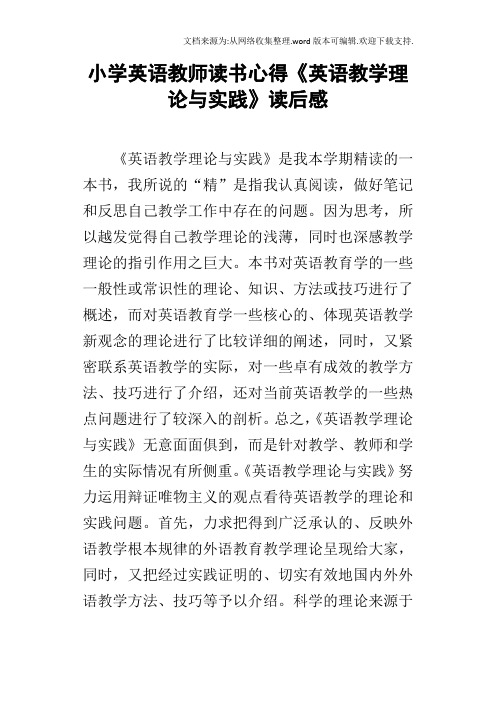
小学英语教师读书心得《英语教学理论与实践》读后感《英语教学理论与实践》是我本学期精读的一本书,我所说的“精”是指我认真阅读,做好笔记和反思自己教学工作中存在的问题。
因为思考,所以越发觉得自己教学理论的浅薄,同时也深感教学理论的指引作用之巨大。
本书对英语教育学的一些一般性或常识性的理论、知识、方法或技巧进行了概述,而对英语教育学一些核心的、体现英语教学新观念的理论进行了比较详细的阐述,同时,又紧密联系英语教学的实际,对一些卓有成效的教学方法、技巧进行了介绍,还对当前英语教学的一些热点问题进行了较深入的剖析。
总之,《英语教学理论与实践》无意面面俱到,而是针对教学、教师和学生的实际情况有所侧重。
《英语教学理论与实践》努力运用辩证唯物主义的观点看待英语教学的理论和实践问题。
首先,力求把得到广泛承认的、反映外语教学根本规律的外语教育教学理论呈现给大家,同时,又把经过实践证明的、切实有效地国内外外语教学方法、技巧等予以介绍。
科学的理论来源于实践,同时又对实践给以指导并进一步为实践所验证。
本学期,我主要把重点放在抓好学生的英语基础知识。
而词汇教学则是重中之重。
那么如何让学生在学习完单词之后,能做到单词音、形、义的结合呢? 这也是我一直苦苦需求答案的问题之一。
本书就提供了很好的方法:那就是教会学生掌握拼读规则和构词规则。
本书提出单词的音、形、义是固有生成的,是不可分拆的。
因为学生在学习英语单词时知道了词义而读不出、写不对的情形往往比读得出、写得对而不知道词义的情形多得多。
另外,由于对“侧重培养学生的阅读能力”的片面理解,各种试题中需要读出、拼写出的部分相对太少,教与学两个方面都存在着轻视读和拼写基本技能的现象,或者存在着对解决读出和拼写出技能低下感到无能为力的心态。
这种轻视与心态已经严重影响了词汇教学的整体质量。
教给学生读出和拼写出的规则以及构词规则,是属于教给学生如何掌握学习策略范畴内的问题。
教师应当特别重视学生学习能力的培养与形成。
英语教学理论与实践

张伊那语言教学理论和实践7月12日内容第一讲语言观与语言学习观思考题:什么是语言?外语教学教什么?第一代:传统语言教学无自觉的语言观,想当然的把语言做为一门知识教。
包括语法知识、词汇、知识和语音知识第二代:结构主义语言观语言是一套形式结构,一套符号系统受行为主义心理学的影响,人们认为,学语言就是要获得操作这套符号系统的技能,用行为主义心理学的术语说,就是训练对刺激作出正确反映的一套语言习惯。
因而,教学一门语言就是通过反复几次训练学生正确操作这门语言的(即一套形式系统)的各种技能。
第三代:交流语言观不仅是以上两种,而是获取人与人交际的一种能力。
能力不排除知识和技能,但是也不等于知识和技能,而是把知识和技能包含进去的,性质起了变化的综合体。
教语言不能停留于教知识、教技能,而要培养能力。
思考题:何为交际能力?交际能力大于语言能力,且包含语言能力交际能力有三个范畴的能力(包含知识、技能、能力)组成:1.语言能力:语言形式结构系统本身的操作能力2.语篇能力:语言形式结构置于语篇中运用的能力3.语用能力:语言形式结构置于情境中运用的能力思考题:交际语言观对语言教学的启示?语言教学必须注意培养以下三个范畴的能力1.语言、语法、词汇知识、词和句的语义知识,听、说、读、写的技能2.语篇规则的知识,语篇组织能力,语篇连接策略等3.实现语言功能的能力、交际策略、社会语言能力、社会文化知识、关于世界的知识等《英语课程标准》所体现的语言观“语言是人类最重要的思维和句,也是人们参与社会的重要条件。
语言对促进人的全面发展具有重要意义。
”“高中学生学习外语,一方面可以促进心智、情感、态度与价值观的发展和综恩问素养的提高;另一方面,掌握一门国际通用语种可以为学习国外先进的文化科学、技术和进行国际交往创造条件。
“注:语言的工具性和人文性有机结合,高度统一。
工具性与人文性也是教育的两大功能。
思考题:人们是如何学习语言的?历史上形形色色的外语学习理论可归结为两个方面相反的主要趋向:1.把人学习外语外语看作是一套心理生理习惯的形成,这是通过模仿和刺激反应的技能训练2.认为人学习外语是在自己的脑子里构造一套新的知识(陈述性知识和程序性知识)系统,这构造的过程强调创造性及认知和情感机能的作用。
基于主题意义探究的英语教学理论与实践
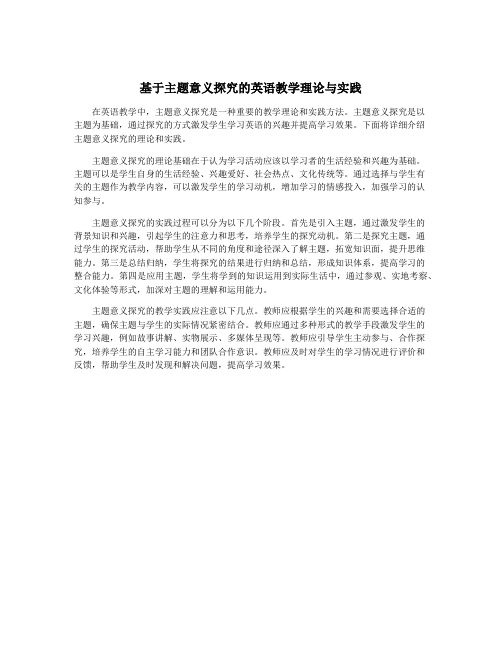
基于主题意义探究的英语教学理论与实践
在英语教学中,主题意义探究是一种重要的教学理论和实践方法。
主题意义探究是以
主题为基础,通过探究的方式激发学生学习英语的兴趣并提高学习效果。
下面将详细介绍
主题意义探究的理论和实践。
主题意义探究的理论基础在于认为学习活动应该以学习者的生活经验和兴趣为基础。
主题可以是学生自身的生活经验、兴趣爱好、社会热点、文化传统等。
通过选择与学生有
关的主题作为教学内容,可以激发学生的学习动机,增加学习的情感投入,加强学习的认
知参与。
主题意义探究的实践过程可以分为以下几个阶段。
首先是引入主题,通过激发学生的
背景知识和兴趣,引起学生的注意力和思考,培养学生的探究动机。
第二是探究主题,通
过学生的探究活动,帮助学生从不同的角度和途径深入了解主题,拓宽知识面,提升思维
能力。
第三是总结归纳,学生将探究的结果进行归纳和总结,形成知识体系,提高学习的
整合能力。
第四是应用主题,学生将学到的知识运用到实际生活中,通过参观、实地考察、文化体验等形式,加深对主题的理解和运用能力。
主题意义探究的教学实践应注意以下几点。
教师应根据学生的兴趣和需要选择合适的
主题,确保主题与学生的实际情况紧密结合。
教师应通过多种形式的教学手段激发学生的
学习兴趣,例如故事讲解、实物展示、多媒体呈现等。
教师应引导学生主动参与、合作探究,培养学生的自主学习能力和团队合作意识。
教师应及时对学生的学习情况进行评价和
反馈,帮助学生及时发现和解决问题,提高学习效果。
英语教学理论及实践报告(3篇)
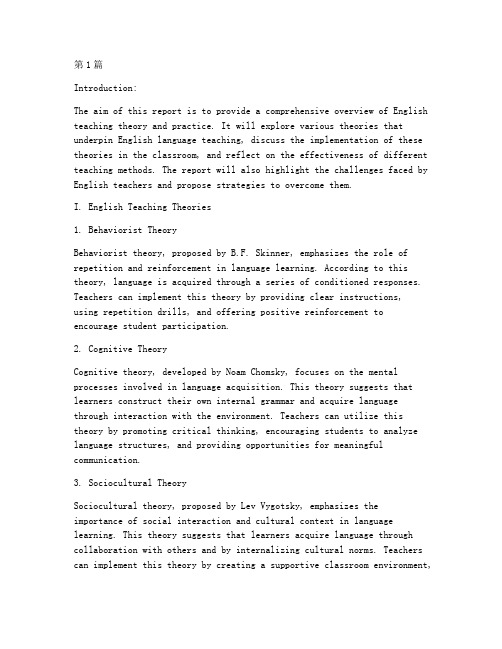
第1篇Introduction:The aim of this report is to provide a comprehensive overview of English teaching theory and practice. It will explore various theories that underpin English language teaching, discuss the implementation of these theories in the classroom, and reflect on the effectiveness of different teaching methods. The report will also highlight the challenges faced by English teachers and propose strategies to overcome them.I. English Teaching Theories1. Behaviorist TheoryBehaviorist theory, proposed by B.F. Skinner, emphasizes the role of repetition and reinforcement in language learning. According to this theory, language is acquired through a series of conditioned responses. Teachers can implement this theory by providing clear instructions,using repetition drills, and offering positive reinforcement to encourage student participation.2. Cognitive TheoryCognitive theory, developed by Noam Chomsky, focuses on the mental processes involved in language acquisition. This theory suggests that learners construct their own internal grammar and acquire language through interaction with the environment. Teachers can utilize this theory by promoting critical thinking, encouraging students to analyze language structures, and providing opportunities for meaningful communication.3. Sociocultural TheorySociocultural theory, proposed by Lev Vygotsky, emphasizes the importance of social interaction and cultural context in language learning. This theory suggests that learners acquire language through collaboration with others and by internalizing cultural norms. Teachers can implement this theory by creating a supportive classroom environment,encouraging group work, and integrating cultural activities into the curriculum.4. Humanistic TheoryHumanistic theory, developed by Carl Rogers, emphasizes the importanceof the individual's personal growth and self-actualization in language learning. This theory suggests that learners are motivated by intrinsic factors and that teachers should focus on creating a positive,supportive classroom atmosphere. Teachers can implement this theory by encouraging student autonomy, promoting self-reflection, and valuing student feedback.II. Implementation of English Teaching Theories in the Classroom1. Behaviorist ApproachIn a behaviorist classroom, teachers can use techniques such as direct instruction, repetition drills, and positive reinforcement to facilitate language learning. For example, teachers can use a grammar workbook to introduce new structures, followed by controlled practice and corrective feedback to ensure students internalize the language.2. Cognitive ApproachA cognitive classroom encourages students to actively engage with the language, analyze its structures, and make connections with theirexisting knowledge. Teachers can use activities such as vocabulary games, reading comprehension exercises, and writing prompts to promote critical thinking and language development.3. Sociocultural ApproachIn a sociocultural classroom, teachers can foster collaboration and cultural awareness through activities such as group projects, cultural exchange programs, and language games. By encouraging students tointeract with peers from different backgrounds, teachers can promote language acquisition and cultural understanding.4. Humanistic ApproachA humanistic classroom focuses on creating a supportive environment that allows students to explore their own identities and express themselves. Teachers can use techniques such as open-ended discussions, reflection activities, and peer assessment to promote student autonomy and self-awareness.III. Challenges and Strategies1. Language BarriersOne of the primary challenges in English language teaching is overcoming language barriers. To address this, teachers can use simple language, visual aids, and gestures to convey their messages effectively. Additionally, providing opportunities for students to practice their speaking and listening skills in a supportive environment can help bridge the language gap.2. Diverse Learning StylesStudents have varying learning styles, which can make it challenging to cater to all learners. To overcome this, teachers can use a variety of teaching methods, such as visual, auditory, and kinesthetic approaches, to engage different types of learners. By incorporating activities that cater to diverse learning styles, teachers can create a more inclusive classroom environment.3. MotivationMaintaining student motivation can be challenging, especially in a language learning context. To address this, teachers can create engaging and relevant lessons, incorporate real-life contexts, and offer opportunities for student choice and autonomy. By making the learning process enjoyable and meaningful, teachers can foster a positiveattitude towards language learning.Conclusion:This report has provided an overview of English teaching theory and practice, highlighting the importance of understanding different theories and their application in the classroom. By incorporatingvarious teaching methods and addressing the challenges faced by English teachers, educators can create an effective and engaging learning environment that promotes language acquisition and personal growth.第2篇IntroductionEnglish language teaching (ELT) has evolved significantly over the years, with various theories and practices shaping the way educators approach the classroom. This report aims to provide a comprehensive overview of key ELT theories and their practical application in the classroom. By examining these theories and practices, we can gain insights into how to create effective and engaging learning environments for English language learners (ELLs).1. Theoretical Frameworks in English Language Teaching1.1 BehaviorismBehaviorism, founded by B.F. Skinner, suggests that learning is a result of behavior modification through reinforcement and punishment. In the context of ELT, behaviorist approaches focus on creating controlled environments where students can practice and perfect their languageskills through repetition and positive reinforcement.1.2 Cognitive DevelopmentCognitive development theory, proposed by Jean Piaget, emphasizes the importance of learners' mental processes in language acquisition. This theory highlights the stages of cognitive development that learners go through, and suggests that teachers should adapt their teaching methods to cater to these stages.1.3 Communicative Language Teaching (CLT)Communicative Language Teaching (CLT) is an approach that focuses on communication as the primary goal of language learning. This theory emphasizes the importance of real-life communication tasks, interaction, and the development of fluency and accuracy. Teachers using CLT oftenemploy techniques such as role-plays, discussions, and group work to promote communication skills.1.4 Task-Based Language Teaching (TBLT)Task-Based Language Teaching (TBLT) is a method that organizes language learning around tasks that learners are likely to encounter in real-life situations. This approach emphasizes the importance of task completion and focuses on the meaning of language rather than just the form. Teachers using TBLT design tasks that require students to use the language in context.1.5 Sociocultural TheorySociocultural theory, proposed by Lev Vygotsky, suggests that learning is a social process that occurs through interaction with others. This theory emphasizes the importance of the cultural context in which learning takes place and the role of the teacher as a facilitator of learning.2. Practical Application of Theories in the Classroom2.1 Behaviorist ApproachIn a behaviorist classroom, teachers can use techniques such as the following:- Direct instruction: Presenting new language structures and vocabulary through explicit teaching.- Drilling: Repeating exercises and activities to reinforce language patterns and structures.- Positive reinforcement: Providing praise and rewards for correct responses and progress.2.2 Cognitive Development ApproachTo apply cognitive development theory in the classroom, teachers can:- Adjust teaching methods to cater to different stages of cognitive development.- Use scaffolding techniques to guide learners through complex tasks.- Provide opportunities for learners to engage in problem-solving activities.2.3 Communicative Language Teaching (CLT)Implementing CLT in the classroom involves:- Designing activities that promote interaction and communication.- Encouraging learners to use the target language in real-life contexts.- Providing opportunities for learners to practice speaking, listening, reading, and writing skills.2.4 Task-Based Language Teaching (TBLT)Incorporating TBLT into the classroom can be achieved through:- Designing tasks that are meaningful and relevant to learners' lives.- Ensuring that tasks require learners to use the target language in context.- Providing feedback and assessment based on task completion and language use.2.5 Sociocultural TheoryApplying sociocultural theory in the classroom includes:- Creating a supportive and collaborative learning environment.- Encouraging learners to interact with peers and share their cultural perspectives.- Facilitating the development of learners' metacognitive skills through guided instruction.3. ConclusionThis report has explored various ELT theories and their practical application in the classroom. By understanding these theories andimplementing their corresponding practices, teachers can createeffective and engaging learning environments for their students. As language learning continues to evolve, it is crucial for educators to stay informed about new theories and methods to ensure that their teaching practices remain relevant and effective.第3篇IntroductionThis report aims to provide an in-depth analysis of English teaching theory and its practical application in the classroom. It explores various theoretical frameworks that guide English language teaching, discusses their implications for classroom practice, and presents a case study of a teaching intervention that integrates these theories.Theoretical Frameworks in English Language Teaching1. Theoretical Approaches to Language Learninga. Behaviorism: This approach, rooted in B.F. Skinner's work, suggests that language is a system of stimulus-response relationships. Teachers can use this theory to design activities that reinforce correct language use.b. Cognitive Approach: Proposed by scholars like Krashen, this approach emphasizes the role of mental processes in language learning.It suggests that learners construct their knowledge of language through interaction and meaningful communication.c. Sociocultural Approach: Based on the work of Vygotsky, this theory highlights the importance of social interaction and cultural context in language learning. It suggests that language is a tool for social interaction and cognitive development.2. Theories of Language Teachinga. The Direct Method: This method, popularized by the oralists, emphasizes the use of the target language in the classroom. It focuseson conversational practice and the development of pronunciation and intonation.b. The Audio-Lingual Method: Also known as the Structural Approach, this method focuses on the systematic presentation and practice of grammatical structures. It uses repetition and rote learning tofacilitate language acquisition.c. The Communicative Approach: This approach, developed in the 1970s, emphasizes communication and interaction as the primary goals of language learning. It encourages teachers to design activities that promote meaningful and purposeful communication.3. Curriculum Development and Assessmenta. Curriculum Development: The curriculum should be designed to meet the needs and interests of learners, as well as the goals of the educational institution. It should incorporate a variety of teaching and learning activities, resources, and assessment methods.b. Assessment: Assessment should be used to evaluate learners' progress and inform teaching decisions. It should be formative, as well as summative, and should include both quantitative and qualitative measures.Practical Application in the ClassroomThe following case study illustrates how a teacher can integrate various theoretical frameworks into classroom practice.Case Study: Integrating Theoretical Frameworks into Classroom PracticeTeacher: Ms. JohnsonGrade Level: 8th GradeSubject: English Language ArtsContext: Ms. Johnson teaches an 8th-grade English class at a public school in a suburban area. The students come from diverse cultural backgrounds and have varying levels of English proficiency.Teaching Intervention1. Behaviorism: Ms. Johnson uses positive reinforcement to encourage students to participate in class discussions. She rewards students who volunteer to answer questions or share their thoughts with stickers or verbal praise.2. Cognitive Approach: To develop students' critical thinking skills, Ms. Johnson designs activities that require students to analyze and evaluate texts. For example, she asks students to compare and contrast characters in a novel and explain their similarities and differences.3. Sociocultural Approach: Ms. Johnson incorporates cultural activities into her lessons to promote understanding and appreciation of diverse cultures. For instance, she organizes a cultural fair where students showcase their heritage and share stories about their families.4. Direct Method: Ms. Johnson uses the target language extensively inher lessons. She encourages students to speak English during class discussions and provides opportunities for them to practice their listening and speaking skills.5. Communicative Approach: Ms. Johnson designs activities that promote meaningful communication. For example, she organizes group projects where students work together to create a presentation on a given topic.AssessmentMs. Johnson uses a variety of assessment methods to evaluate herstudents' progress. These include:- Quizzes and tests to measure students' knowledge of grammar and vocabulary.- Oral presentations to assess students' speaking and listening skills.- Writing assignments to evaluate students' writing abilities.- Portfolios to track students' progress over time.ConclusionThis report has explored various theoretical frameworks in English language teaching and their practical application in the classroom. By integrating these theories into their teaching practice, teachers can create a more engaging and effective learning environment for their students. The case study presented demonstrates how a teacher can successfully implement these theories to enhance students' language learning experiences.。
浅析英语教学中理论和实践的关系-精选教育文档

浅析英语教学中理论和实践的关系(宁晋县第二中学河北宁晋 055550)在英语教学中如何处理理论和实践的关系,历来是有争议的。
远不讲,就从目前存在的两种理论来说,听说习惯习得理论认为“浯言是习惯的体系”。
学习英语要靠模仿记忆,反复操练,直到形成新的语言习惯,这有它正确的一面,因为语言是交际工具,培养交际能力需要大量练习。
但这种学习理论把人的学习局限于条件反射,完全忽视人的主观能动性、逻辑思考能力和理论知识的作用,这是它的片面性。
认知学习理论与听说习得理论恰恰相反。
认为学习语言是一种创造性活动,重视智力和掌握语言规则对学习英语的促进作用,这一点无疑是正确的。
但是它对运用语言是一种高度熟练的技能,需要形成习惯这点估计不足,从一个极端走向另一个极端。
无论是经验论,还是唯理论,都把感性认识和理论认识、理论和实践绝对对立起来,承认一个,否定另一个。
所以从认识的总体上看,都是错误的。
根据马克思主义哲学的认识论和方法论以及语言学和心理学等学科的最新成果,下面对英语教学中理论和实践的关系试作粗浅解析。
1. 自觉实践英语是交际工具之一,学习英语的根本目的是把语言作为交际工具来掌握。
人们运用语言进行交际时要求熟练地运用语言材料。
从心理学角度看,在交际时人们的注意力集中在思想内容上,而不是在表达思想内容的语言材料上,因为此时语言材料已掌握到不假思索、脱口而出的程度。
可见掌握语言是一种高度的言语(材料)技能。
这种言语技能是靠长时间大量的言语实践活动获得的。
有的学者统计,在自然的母语环境里,儿童习得听说能力需要一万八千多个小时,之后经过小学、中学近三干多课时语文课的学习才能掌握阅读和写作能力。
学习英语要把英语作为交际工具来掌握,同样要靠大量的言语实践活动。
当人们向美国结构主义语言学家布隆菲尔德教学习外语的方法时,他答复说:实践、实践、再实践,别的方法是没有的。
这表明:实践是学会外语的基本途径。
从信息论、控制论角度来看,学习英语即是通过听觉器官输入教师发出的语言信息,然后通过对信息的储存和提取来掌握语言。
- 1、下载文档前请自行甄别文档内容的完整性,平台不提供额外的编辑、内容补充、找答案等附加服务。
- 2、"仅部分预览"的文档,不可在线预览部分如存在完整性等问题,可反馈申请退款(可完整预览的文档不适用该条件!)。
- 3、如文档侵犯您的权益,请联系客服反馈,我们会尽快为您处理(人工客服工作时间:9:00-18:30)。
Structural View (2)
Areas of research drawn on
Here are some of the areas anguage:
• Linguistic analysis • Textual discourse analysis • Target of language learning • The target of language learning, in the
e. Expressing thanks f. Asking the way g. Dating… 2. What is function? 3. What is the notion? Examples of notions: a. Notions of time b. Certainty and possibility c. Roles ,instruments and Special relationships
knowwhat/how/when/
Structural View (1)
The structural view of lg: • Grammatical units
1) Phonology (语音学)
(phrases, clauses,
2) Morphology (形态学/词法)
sentences)
3) Syntax (句法学)
• Grammatical operations (adding,
Language and Language Learning
1. People started learning a foreign language at different ages.
2. Different people have different experiences in learning a foreign language.
Functional View
Interactional View
Interactional view:
Communicative contexts
Communicative tool
Summary:
Establish social relations Structural view:
Maintain social relations Structural rules and voc.
Learners’ tasks:
Functional view:
a. Grammar
To use the rules and voc.
b. Vocabulary
Interactional view:
c. Rules for using them Appropriancy :To
In a whole range of
• The Audio-lingual method • Total Physical Response • The Silent Way
Structural View (4)
Functional View
Johnson & Morrow(1981): 1. Syllabus based on Communicative functions 2. Functional view a. Lg: linguistic system b. Means for doing things 3. Functional activities a. Offering b. Suggesting c. Advising d. Apologizing
3. Different people have different reasons in learning a foreign language.
4. People learn a foreign lg in different lgs. 5. Different people have different capabilities 6. The way you learn is the way you teach.
By Ma Bingjun
Foreign Languages School of
Fuyang Teachers College
English Teaching Theory and Practice
Unit 1 Language and Language Learning
1. When did you start learning the foreign language (s)? 2. How do you feel about learning a language? 3. Why do you learn a foreign language? 4. In what way are you learning a foreign language? Do you think you’re efficient/successful learner? 5. Do you like the way you learnt the foreign lg? 6. How do you think you’ll teach in the future?
( phrases, clauses, sentences ) shifting, joining or
• Phonological units
transforming
(phonemes)
elements)
• Lexical items (function words and structure words)
structural view, is the mastery of elements of this system.
Structural View (3)
Methods based on this view Some of the language learning methods based on this view of language are:
